Trauma Reconstructive Surgery in Hyderabad

Introduction
Trauma reconstructive surgery restores function and aesthetics after severe injuries, burns, or accidents. This specialized surgical procedure helps patients regain mobility, confidence, and a sense of normalcy.
What is Trauma Reconstructive Surgery?
It involves repairing damaged tissues, bones, and nerves using advanced surgical techniques to improve function and appearance after trauma.
Benefits of Trauma Reconstructive Surgery
- Restores mobility and functionality
- Improves aesthetics and self-confidence
- Enhances wound healing and tissue repair
- Minimizes scarring and disfigurement
Who is an Ideal Candidate?
- Patients with severe injuries, burns, or fractures
- Individuals suffering from nerve damage or tissue loss
- People needing corrective procedures post-accident
Procedure Details
- Varies based on the type and severity of injury
- May involve grafting, tissue transfer, or microsurgery
- Can require multiple staged procedures
Recovery & Aftercare
- Initial healing may take weeks to months
- Physiotherapy may be needed for rehabilitation
- Regular follow-ups are essential for monitoring progress
Why Choose Dr. Sindhuri Kondapavuluri?
- Expertise in complex reconstructive procedures
- Comprehensive care and post-surgical rehabilitation
- Advanced techniques for better results
FAQs
Q: How long does recovery take?
A: Recovery time varies based on the complexity of the injury and surgery.
Q: Will I need multiple surgeries?
A: Some cases require staged surgeries for optimal results.
A Detailed Explanation of the Procedure
A hair transplant involves transferring healthy hair follicles from a donor area (typically the back of the head) to areas experiencing hair loss. The two main methods include:
- Follicular Unit Transplantation (FUT): A strip of hair-bearing skin is removed and divided into grafts.
- Follicular Unit Extraction (FUE): Individual hair follicles are extracted and implanted.
Benefits of Hair Transplant
- Permanent, natural-looking results
- Minimally invasive with quick recovery
- Enhances confidence and self-esteem
- No major side effects when performed by an expert
Ideal Candidates
- Individuals with male or female pattern baldness
- People with thinning hair or receding hairlines
- Those who have lost hair due to injuries or medical treatments
Procedure Details
- Local anesthesia is administered
- Hair follicles are extracted and prepared for implantation
- The surgeon creates micro-incisions for transplantation
- The follicles are implanted, ensuring a natural hairline
- The procedure takes 4-8 hours depending on the extent
Recovery & Aftercare
- Mild swelling or redness for a few days
- Avoid strenuous activities for a week
- Hair shedding occurs initially but new growth starts within months
- Full results visible in 6-12 months
Why Choose Dr. Sindhuri Kondapavuluri?
- Expert in advanced hair restoration techniques
- Personalized approach for optimal results
- State-of-the-art facility with high success rates
FAQs
Q1: How soon will I see results? A: Initial shedding occurs, but new hair growth starts in 3-4 months, with full results in 6-12 months.
Q2: Is a hair transplant painful? A: Local anesthesia is used, ensuring minimal discomfort.
Q3: How long do the results last? A: Hair transplants offer permanent results as the transplanted follicles retain their original characteristics.
